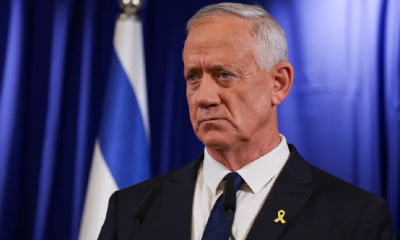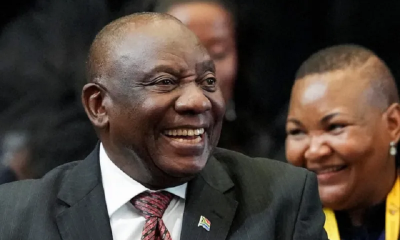Latest News
South Africa files ‘genocide’ case against Israel at ICJ
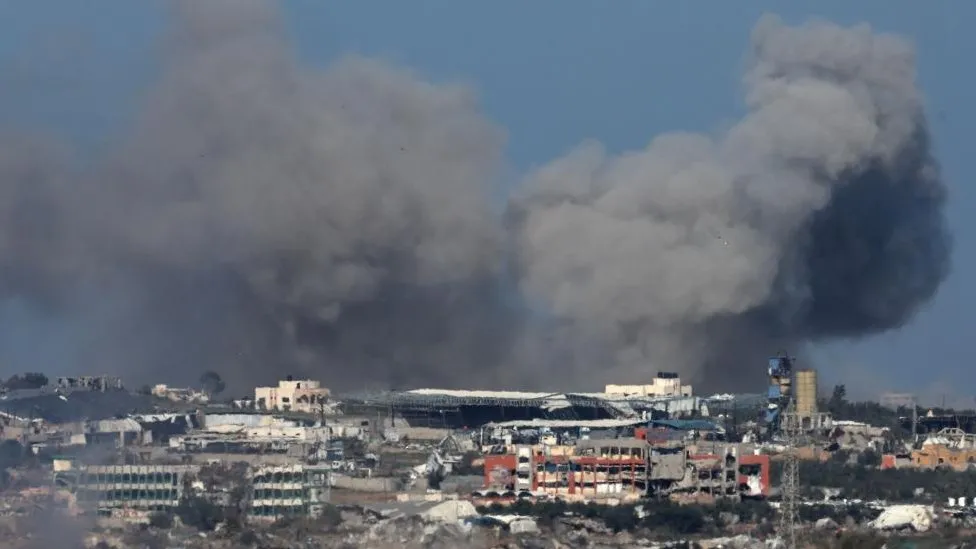
South Africa has filed a case at the International Court of Justice (ICJ) alleging that Israel is engaging in “genocidal acts” in Gaza.
The UN court confirmed the proceedings concerning alleged violations of Israel’s obligations under the Genocide Convention. Israel has strongly rejected the allegation, calling it “baseless”. “Israel rejects with disgust the blood libel spread by South Africa”, the foreign ministry said.
The ICJ, which is based in the Hague in the Netherlands, is the UN’s principal legal body. It settles disputes between states and gives advisory opinions on international legal issues.
Following its application to the ICJ, South Africa’s presidency said in a statement that the country was obliged “to prevent genocide from occurring”. “South Africa is gravely concerned with the plight of civilians caught in the present Israeli attacks on the Gaza Strip due to the indiscriminate use of force and forcible removal of inhabitants,” it said.
“Furthermore, there are ongoing reports of international crimes, such as crimes against humanity and war crimes, being committed as well as reports that acts meeting the threshold of genocide or related crimes… have been and may still be committed in the context of the ongoing massacres in Gaza.”
The 84 page document states that the “acts and omissions by Israel” are “genocidal in character because they are intended to bring about the destruction of a substantial part of the Palestinian national, racial and ethnical group”.
The application asks the ICJ for a hearing to take place next week and requests that a number “provisional measures” be indicated by the court, including that Israel cease all military activities in Gaza.
Lior Haiat, a spokesman for Israel’s foreign affairs ministry, said South Africa’s claim “constitutes despicable and contemptuous exploitation of the Court.”
He said South Africa was “cooperating with a terrorist organisation that is calling for the destruction of the State of Israel” and said Hamas was “responsible for the suffering of the Palestinians in the Gaza Strip by using them as human shields and stealing humanitarian aid from them”. “Israel is committed to international law and acts in accordance with it, and directs its military efforts only against the Hamas terrorist organization and the other terrorist organizations cooperating with Hamas,” Mr Haiat said. “Israel has made it clear that the residents of the Gaza Strip are not the enemy, and is making every effort to limit harm to the non-involved and to allow humanitarian aid to enter the Gaza Strip.”
South Africa has been highly critical of Israel’s military operation in Gaza. In early November, it recalled all of its diplomats from Israel. Israel, in turn, recalled its ambassador from Pretoria.
In addition, the South African national assembly voted to suspend all diplomatic relations with Israel, but the government has not yet formally responded to the vote.
South Africa previously filed a referral to a different court, the International Criminal Court (ICC), relating to alleged war crimes by Israel in Gaza. The ICC investigates and tries individuals charged with genocide, war crimes, and crimes against humanity. Israel does not recognise the ICC.
The current war between Israel and Hamas was triggered by the 7 October Hamas attack on southern Israel, which killed about 1,200 people – most of them civilians – and saw about 240 others taken hostage.
More than 21,500 people have been killed in Gaza – mostly children and women – during Israeli retaliatory attacks on Gaza, according to the Hamas-run health ministry.
(BBC)
Latest News
Tourists and residents evacuated as volcano erupts in Iceland
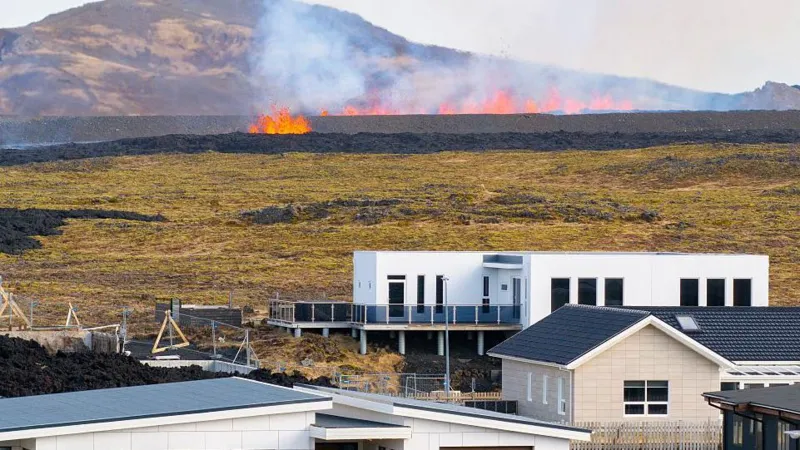
Tourists and residents have been evacuated as a volcano erupted in south-west Iceland, threatening a town and popular attraction.
The volcano has been spewing lava and smoke in a fiery display of orange and red since the eruption began in the morning, creating a huge crack in the ground which has grown to 1.2km (0.75 miles) long.
Multiple earthquakes have occurred in the volcanic area throughout the day.
The volcano is close to the fishing town of Grindavik and the famous Blue Lagoon spa. A small number of people refused to evacuate the town, local media reported.
People were asked to “leave the danger zone,” the region’s police commissioner, Ulfar Ludviksson, told Iceland’s RUV broadcaster. But he said individuals staying in “seven or eight houses there… have decided to remain in the town.”
There were fears that the town was “in danger of having lava flows entering the inhabited area”, said Rikke Pedersen from the Nordic Volcanological Centre.
A hot water pipe has broken in the northern part of Grindavík, which confirms that considerable cracking has occurred within the town, the Icelandic Meteorological Office (IMO) said.
The protective barriers around Grindavik have also been breached, as new eruptive fissure opened a few hundred meters inside, the IMO reported. But volcanic activity eased off in the early afternoon on Tuesday.
Roads in and out of the town remain closed, but flights are currently not affected.
Most of the 4,000 residents of Grindavík left in a mass evacuation in 2023 because of the dangers of the volcanic activity. The volcano has erupted several times since.
The length of the magma that formed on Tuesday under the crater series stretched to about 11 km (6.8 miles) – the longest that has been measured since 11 November 2023, meteorologists said. The magma corridor extends about 3km further northeast than seen in previous eruptions.
Based on current wind direction, gas pollution from the eruption will travel northeast towards the capital area, the IMO added.
The eruption, which began around 09.45 local time (10:45 BST), occurred after several earthquakes hit the area known as the Sundhnúk crater range.
Multiple eruptions have occurred on the Reykjanes Peninsula since 2021. The last time the peninsula had a period of volcanic activity was 800 years ago – and the eruptions continued for decades.
Iceland has 33 active volcano systems and sits over what is known as the Mid-Atlantic Ridge, the boundary between two of the largest tectonic plates on the planet.
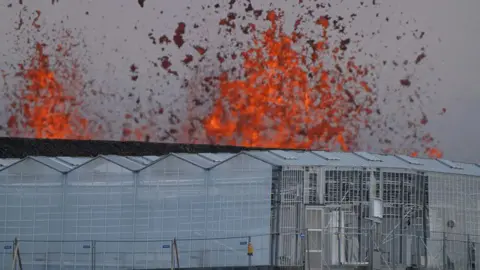
[BBC]
Latest News
Mandalay was the ‘city of gold’ – now it reeks of death
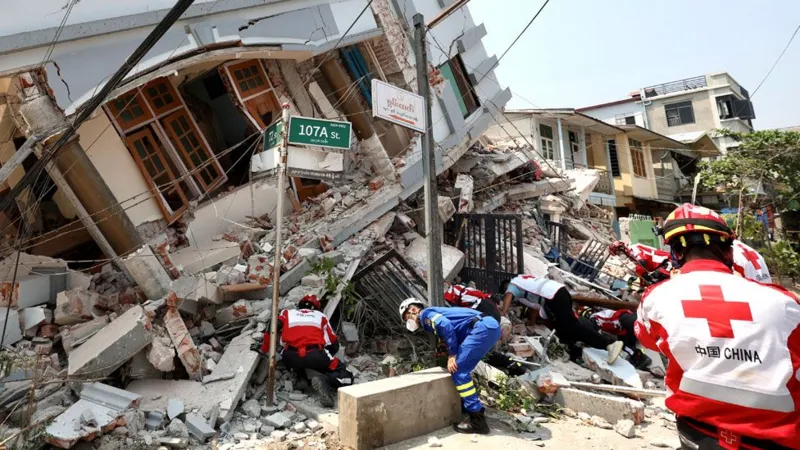
Mandalay used to be known as the city of gold, dotted by glittering pagodas and Buddhist burial mounds, but the air in Myanmar’s former royal capital now reeks of dead bodies.
So many corpses have piled up since a 7.7 magnitude earthquake struck last Friday close to Mandalay, that they have had to be “cremated in stacks”, one resident says.
The death toll from the quake and a series of aftershocks has climbed past 2,700, with 4,521 injured and hundreds still missing, Myanmar’s military chief said. Those figures are expected to rise.
Residents in the country’s second most populous city say they have spent sleepless nights wandering the streets in despair as food and water supplies dwindle.
The Mandalay resident who spoke of bodies being “cremated in stacks” lost her aunt in the quake.
“But her body was only pulled out of the rubble two days later, on 30 March,” said the 23-year-old student who wanted only to be known as J.
Poor infrastructure and a patchwork of civil conflicts are severely hampering the relief effort in Myanmar, where the military has a history of suppressing the scale of national disasters. The death toll is expected to keep rising as rescuers gain access to more collapsed buildings and cut-off districts.
J, who lives in Mandalay’s Mahaaungmyay district, has felt “dizzy from being deprived of sleep”, she said.
Many residents have been living out of tents – or nothing – along the streets, fearing that what’s left of their homes will not hold up against the aftershocks.
“I have seen many people, myself included, crouching over and crying out loud on the streets,” J said.
But survivors are still being found in the city. The fire service said it had rescued 403 people in Mandalay in the past four days, and recovered 259 bodies. The true number of casualties is thought to be much higher than the official version.
In a televised speech on Tuesday, military chief Min Aung Hlaing said the death toll may exceed 3,000, but the US Geological Survey said on Friday “a death toll over 10,000 is a strong possibility” based on the location and size of the quake.
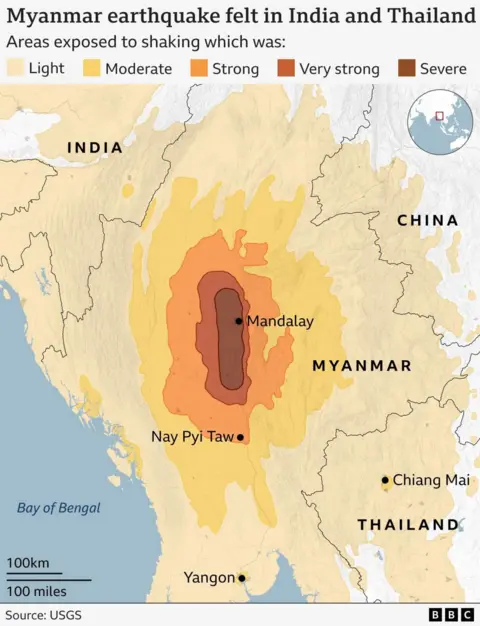
Young children have been especially traumatised in the disaster.
A local pastor told the BBC his eight-year-old son had burst into tears all of a sudden several times in the last few days, after witnessing parts of his neighbourhood buried under rubble in an instant. “He was in the bedroom upstairs when the earthquake struck, and my wife was attending to his younger sister, so some debris had fallen onto him,” says Ruate, who only gave his first name. “Yesterday we saw bodies being brought out of collapsed buildings in our neighbourhood,” said Ruate, who lives in the Pyigyitagon area.
“It’s very sobering. Myanmar has been hit by so many disasters, some natural, some human made. Everyone’s just gotten so tired. We are feeling hopeless and helpless.”
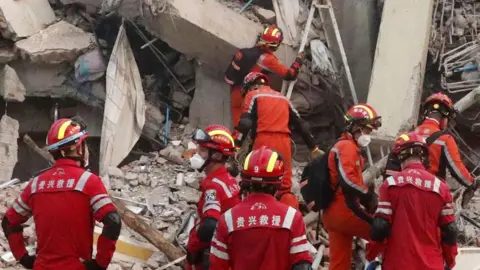
A monk who lives near the Sky Villa condominium, one of the worst-hit buildings reduced from 12 to six storeys by the earthquake, told the BBC that while some people had been pulled out alive, “only dead bodies have been recovered” in the past 24 hours. “I hope this will be over soon. There are many bodies still inside, I think more than a hundred,” he said.
Crematoriums close to Mandalay have been overwhelmed, while authorities have been running out of body bags, among other supplies, including food and drinking water.
Around the city, the remains of crushed pagodas and golden spires line the streets. While Mandalay used to be a major centre for the production of gold leaf and a popular tourist destination, poverty in the city has soared in recent years, as with elsewhere in Myanmar (formerly called Burma).
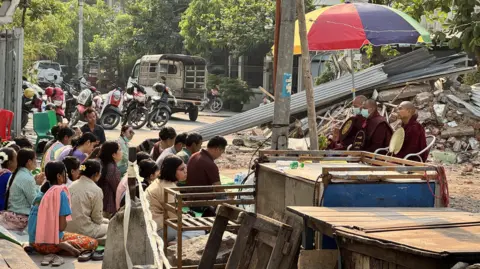 BBC Burmese
BBC BurmeseLast week’s earthquake also affected Thailand and China, but itsnimpact has been especially devastating in Myanmar, which has been ravaged by a bloody civil war, a crippled economy and widespread disillusionment since the military took power in a coup in 2021.
On Tuesday, Myanmar held a minute of silence to remember victims, part of a week of national mourning. The junta called for flags to fly at half mast, media broadcasts to be halted and asked people to pay their respects.
Even before the quake, more than 3.5 million people had been displaced within the country.
Thousands more, nany of them young people, have fled abroad to avoid forced conscription – this means there are fewer people to help with relief work, and the subsequent rebuilding of the country.
Russia and China, which have helped prop up Myanmar’s military regime, are among countries that have sent aid and specialist support.
But relief has been slow, J said.
“The rescue teams have been working non-stop for four days and I think they are a little tired. They need some rest as well.
“But because the damage has been so extensive, we have limited resources here, it is simply hard for the relief workers to manage such massive destruction efficiently,” she said.
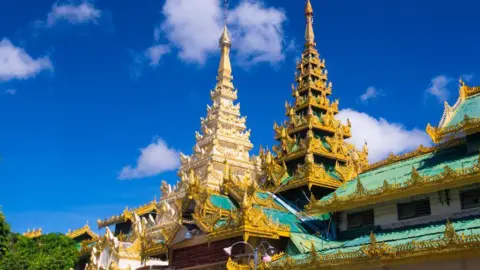
While the junta had said that all assistance is welcome, some humanitarian workers have reported challenges accessing quake-stricken areas.
Local media in Sagaing, the earthquake’s epicentre, have reported restrictions imposed by military authorities that require organisations to submit lists of volunteers and items that they want to bring into the area.
Several rights groups, including Human Rights Watch and Amnesty International, have urged the junta to allow aid workers immediate access to these areas.
“Myanmar’s military junta still invokes fear, even in the wake of a horrific natural disaster that killed and injured thousands,” said Bryony Lau, Human Rights Watch’s deputy Asia director.
“The junta needs to break from its appalling past practice and ensure that humanitarian aid quickly reaches those whose lives are at risk in earthquake-affected areas,” she said.
The junta has also drawn criticism for continuing to open fire on villages even as the country reels from the disaster.
[BBC]
Latest News
PM visits France to attend high-level conference at UNESCO

The Prime Minister of Sri Lanka Dr. Harini Amarasuriya is on an official visit to Paris, France to participate in the high-level segment of the International Expert Conference on ’An Integrated and Sustainable Approach to Safeguarding the World Heritage Property of the Sacred City of Anuradhapura in Sri Lanka and Associated Living Heritage’ which was to be held at UNESCO Headquarters today [Tuesday 1 April], with the participation of the Director-General of UNESCO Audrey Azoulay.
The Conference, organized by UNESCO in partnership with Sri Lanka, brings together leading international experts to discuss sustainable strategies for the conservation of Anuradhapura, a UNESCO World Heritage Site of immense cultural and historical significance.
On the sidelines of the Conference, the Prime Minister is also scheduled to meet senior interlocutors of the French Government to discuss bilateral cooperation and areas of mutual interest.
The Delegation of the Prime Minister includes the Minister of Buddhasasana Religious and Cultural Affairs, Dr. Hiniduma Sunil Senevi.
[Prime Minister’s Media Division]
-

 Sports3 days ago
Sports3 days agoSri Lanka’s eternal search for the elusive all-rounder
-

 Features7 days ago
Features7 days agoCelebrating 25 Years of Excellence: The Silver Jubilee of SLIIT – PART I
-

 News4 days ago
News4 days agoGnanasara Thera urged to reveal masterminds behind Easter Sunday terror attacks
-

 Business7 days ago
Business7 days agoCEB calls for proposals to develop two 50MW wind farm facilities in Mullikulam
-

 Business5 days ago
Business5 days agoAIA Higher Education Scholarships Programme celebrating 30-year journey
-

 Features7 days ago
Features7 days agoNotes from AKD’s Textbook
-

 News2 days ago
News2 days agoBid to include genocide allegation against Sri Lanka in Canada’s school curriculum thwarted
-

 News3 days ago
News3 days agoComBank crowned Global Finance Best SME Bank in Sri Lanka for 3rd successive year





